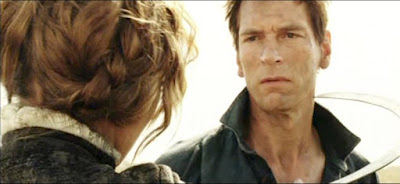I have to hand it to director Paco Plaza: There's a scene in Werewolf Hunter: The Legend of Romasanta (2004) that gave me the heebie jeebies. And it's a gross-out scene, too. Well, kind of a gross-out. It relies on context rather than viscera--not there there's not viscera aplenty in this movie. I'll come to this in a bit.
The title of this film suggests a werewolf picture. I suppose it delivers on that promise, transformation sequence and all, but it would be disingenuous of me to elaborate on the film without dispelling the notion that this is about the classical werewolf. This is, in fact, a pathological case study mounted in the idiom of the Gothic. It takes place in 1851, when wolves--and something worse than wolves--are plaguing Galicia, Spain. A bounty has been declared on wolves, while the authorities are making uncomfortable discoveries about the condition of the victims. There's a murderer out there who is using the cover of the wolves to commit ghastly crimes.
Did I mention that this is a "true" story? Well, it is.
The culprit in all of this is one Miguel Romasanta, who the film describes as the first serial killer. That's debatable. I'm sure that there are plenty of other candidates for that title, from Procrustes through Elizabeth Bathory. In the film, Romasanta is played by Julian Sands, an actor known for playing high-strung characters. He underplays Romasanta beautifully. Romasanta is a kind of wandering peddler, who makes soap from the rendered fat of his victims. There's a sequence in the first half of the film showing just how he goes about this, and while this sequence didn't squick me out, it feeds the one that did. Romasanta also writes letters for people, a valuable service for an illiterate population and an occupation that gains him entry into the lives of his victims. When the movie catches up to him, he is working his way through the Garcia family, which is all women after their lone male member is killed by a wolf trap. He kills the mute girl, Theresa, and her mother, Maria, then turns his attention to Barbara, who fancies him. Following the soap-making sequence, there's a scene where Romasanta seduces Barbara while she's in her bath. He does this by soaping her up with the soap that he's just made from human fat! This is the scene that got to me, particularly when the hand with the soap went between her legs. Eeww!
Okay, I know that's tame, but the thing about horror is that it's entirely subjective and this sequence put its finger on one of my own raw nerves. Your mileage may vary.
Barbara, played by Elsa Pataky, is the heroine of the piece. Once she discovers what Romasanta is, she becomes the werewolf hunter of the title. To its credit, the movie doesn't turn her into an anachronism or some kind of butch ideal of a heroine, but she is persistent and motivated. The other major characters in the film are Dr. Philips, the alienist; Antonio, Romasanta's partner in crime (who in real life may or may not have been real); and Bastida, the district attorney.

The film itself is gorgeous. Plaza makes the most of his limited means, pouring his budget into evocative locations and beautiful production and costume designs. This is a full-dress Gothic, in spite of the way it spans contemporary psychological theories. this kind of pathological case study may be the way that the Gothic manages to stay relevant. Between this film and Tom Tykwer's Perfume, it has a fair success rate. This is one of the best-looking films from Brian Yuzna's Fantastic Factory; Yuzna was in the right place at the right time when he set up shop. Spain, as much as any other place on the globe, is where the action is in the horror genre. Paco Plaza went on to make [•REC] with Jaume Balaguero, but he demonstrates a fine sensibility of his own in this movie. In addition to the scene I describe above, there are a couple of other moments of horror that are distinctive: First among these is a scene where Romasanta puts out a birds ears shortly before putting out a little girl's eyes. The filmmakers are unsentimental and ruthless about these things, which gives the film a bit of a mean streak. Not that that's a bad thing. On the whole, it's a modest success, but then, it's only modestly ambitious.
Current Challenge tally:
Total Viewings: 30
First Time Viewings: 30
















No comments:
Post a Comment